park assist VOLVO XC60 2018 Owner´s Manual
[x] Cancel search | Manufacturer: VOLVO, Model Year: 2018, Model line: XC60, Model: VOLVO XC60 2018Pages: 660, PDF Size: 11.77 MB
Page 10 of 660
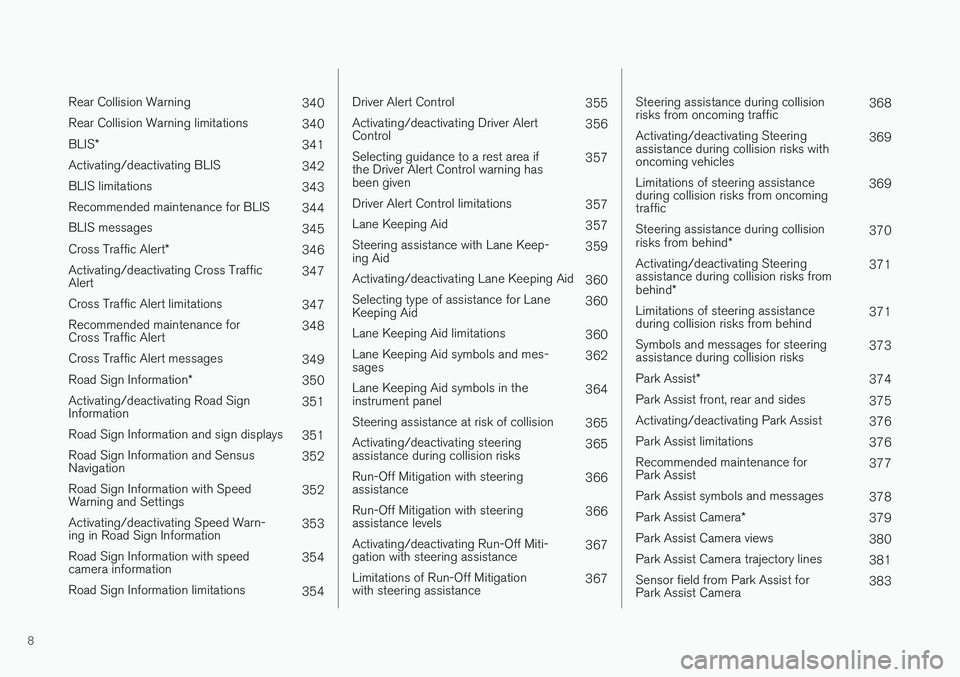
8
Rear Collision Warning340
Rear Collision Warning limitations 340
BLIS *
341
Activating/deactivating BLIS 342
BLIS limitations 343
Recommended maintenance for BLIS 344
BLIS messages 345
Cross Traffic Alert *
346
Activating/deactivating Cross Traffic Alert 347
Cross Traffic Alert limitations 347
Recommended maintenance forCross Traffic Alert 348
Cross Traffic Alert messages 349
Road Sign Information *
350
Activating/deactivating Road SignInformation 351
Road Sign Information and sign displays 351
Road Sign Information and SensusNavigation 352
Road Sign Information with SpeedWarning and Settings 352
Activating/deactivating Speed Warn-ing in Road Sign Information 353
Road Sign Information with speedcamera information 354
Road Sign Information limitations 354
Driver Alert Control355
Activating/deactivating Driver Alert Control 356
Selecting guidance to a rest area ifthe Driver Alert Control warning hasbeen given 357
Driver Alert Control limitations 357
Lane Keeping Aid 357
Steering assistance with Lane Keep-ing Aid 359
Activating/deactivating Lane Keeping Aid 360
Selecting type of assistance for LaneKeeping Aid 360
Lane Keeping Aid limitations 360
Lane Keeping Aid symbols and mes-sages 362
Lane Keeping Aid symbols in theinstrument panel 364
Steering assistance at risk of collision 365
Activating/deactivating steeringassistance during collision risks 365
Run-Off Mitigation with steeringassistance 366
Run-Off Mitigation with steeringassistance levels 366
Activating/deactivating Run-Off Miti-gation with steering assistance 367
Limitations of Run-Off Mitigationwith steering assistance 367
Steering assistance during collision risks from oncoming traffic368
Activating/deactivating Steeringassistance during collision risks withoncoming vehicles 369
Limitations of steering assistanceduring collision risks from oncomingtraffic 369
Steering assistance during collision risks from behind * 370
Activating/deactivating Steering assistance during collision risks from behind * 371
Limitations of steering assistance during collision risks from behind 371
Symbols and messages for steeringassistance during collision risks 373
Park Assist *
374
Park Assist front, rear and sides 375
Activating/deactivating Park Assist 376
Park Assist limitations 376
Recommended maintenance forPark Assist 377
Park Assist symbols and messages 378
Park Assist Camera *
379
Park Assist Camera views 380
Park Assist Camera trajectory lines 381
Sensor field from Park Assist forPark Assist Camera 383
Page 11 of 660

9
Starting the Park Assist Camera384
Park Assist Camera limitations 384
Recommended maintenance of the Park Assist Camera 386
Park Assist Camera symbols andmessages 387
Park Assist Pilot *
388
Types of parking with Park Assist Pilot 388
Parking with Park Assist Pilot 389
Leaving a parking space with ParkAssist Pilot 392
Park Assist Pilot * limitations
393
Recommended maintenance forPark Assist Pilot 395
Park Assist Pilot * messages
396
STARTING AND DRIVING
Starting the vehicle
398
Switching off the vehicle 400
Ignition modes 401
Selecting ignition mode 402
Brake functions 402
Brakes 403
Brake Assist System 404
Braking on wet roads 404
Braking on salted roads 405
Maintenance of the brake system 405
Parking brake 405
Activating and deactivating the park- ing brake 406
Settings for automatically activatingthe parking brake 407
Parking on a hill 408
Parking brake malfunction 408
Auto-hold brakes 409
Activating and deactivating Auto-hold at a standstill 410
Hill Start Assist 410
Braking assist after a collision 411
Transmission 411
Gear selector positions for automatictransmissions 412
Using the steering wheel paddles
* to
shift 413
Shiftlock 415
Deactivating the automatic shiftlock 415
The kickdown function 416
Gear indicator *
416
All Wheel Drive (AWD) *
417
Drive modes *
417
Changing drive mode *
419
ECO drive mode 420
Activating and deactivating ECO drive mode using the function button 422
Start/Stop function 422
Driving with the Start/Stop function 422
Temporarily deactivating the Start/Stop function 424
Conditions for the Start/Stop function 424
Leveling control * and suspension
426
Leveling control settings *
429
Low Speed Control *
429
Activating and deactivating Low Speed Control * using the function button 430
Hill Descent Control *
431
Activating and deactivating HillDescent Control * using the function
button 432
Page 30 of 660

||
YOUR VOLVO
* Option/accessory.
28 goal. In addition to continuous environmental refinement of conventional gasoline-poweredinternal combustion engines, Volvo is activelylooking at advanced technology alternative-fuelvehicles. When you drive a Volvo, you become our partner in the work to lessen the vehicle's impact on theenvironment. To reduce your vehicle's environ-mental impact, you can:
• Maintain proper air pressure in your tires.Tests have shown decreased fuel economywith improperly inflated tires.
• Follow the recommended maintenanceschedule in your Warranty and ServiceRecords Information booklet.
• Drive at a constant speed whenever possible.
• See a trained and qualified Volvo servicetechnician as soon as possible for inspectionif the check engine (malfunction indicator)light illuminates, or stays on after the vehiclehas started.
• Properly dispose of any vehicle-related wastesuch as used motor oil, used batteries, brakepads, etc.
• When cleaning your vehicle, please use gen-uine Volvo car care products. All Volvo carcare products are formulated to be environ-mentally friendly.
Related information
•Economical driving (p. 432)
• The Owner's Manual and the environment(p. 23)
• Air quality (p. 203)
IntelliSafe - driver support
IntelliSafe is Volvo Cars' philosophy regarding vehicle safety. IntelliSafe consists of a number ofsystems, both standard and optional, that aredesigned to help make driving safer, preventaccidents and protect passengers and otherroad users.
SupportIntelliSafe includes driver support functions such as Adaptive cruise control * which helps the driver
to maintain an even speed combined with a pre- selected time interval to the vehicle ahead. Pilot Assist 4
helps the driver keep the vehicle in
the current traffic lane by providing steering assistance and maintaining an even speed and aset time interval to the vehicle ahead. Park Assist Pilot * helps the driver pull into and
out of parking spaces. Other examples of systems that can help the driver are the Active main beam, Cross Traffic Alert (CTA) * and Blind Spot Information (BLIS) *
systems.
PreventionCity Safety is a function intended to help prevent accidents. The function can help prevent or miti-gate a collision with pedestrians, cyclists, largeanimals or other vehicles. Light, sound and pulsa-tions in the brake pedal are provided to alert of a
4 Depending on market, this function can be either standard or optional.
Page 41 of 660

YOUR VOLVO
39
Driver distraction
A driver has a responsibility to do everything possible to ensure his or her own safety and thesafety of passengers in the vehicle and otherssharing the roadway. Part of this responsibility isavoiding distractions, including performing activi-ties that are not directly related to controlling thevehicle in the driving environment.
Your new Volvo is, or can be, equipped with fea- ture-rich entertainment and communication sys-tems. These include hands-free cellular tele-phones, navigation systems, and multipurposeaudio systems. You may also own other portableelectronic devices for your own convenience.When used properly and safely, they enrich thedriving experience. Improperly used, any of thesecould cause a distraction. For all of these systems, we want to provide the following warning that reflects the strong Volvoconcern for your safety. Never use these devicesor any feature of your vehicle in a way that dis-tracts you from the task of driving safely. Distrac-tion can lead to a serious accident. In addition tothis general warning, we offer the following guid-ance regarding specific new features that may befound in your vehicle:
WARNING
• Never use a hand-held cellular telephone while driving. Some jurisdictions prohibitcellular telephone use by a driver whilethe vehicle is moving.
• If your vehicle is equipped with a naviga-tion system, set and make changes toyour travel itinerary only with the vehicleparked.
• Never program your audio system whilethe vehicle is moving. Program radio pre-sets with the vehicle parked, and use yourprogrammed presets to make radio usequicker and simpler.
• Never use portable computers or per-sonal digital assistants while the vehicleis moving.
Related information
•Audio, media and Internet (p. 458)
Page 117 of 660
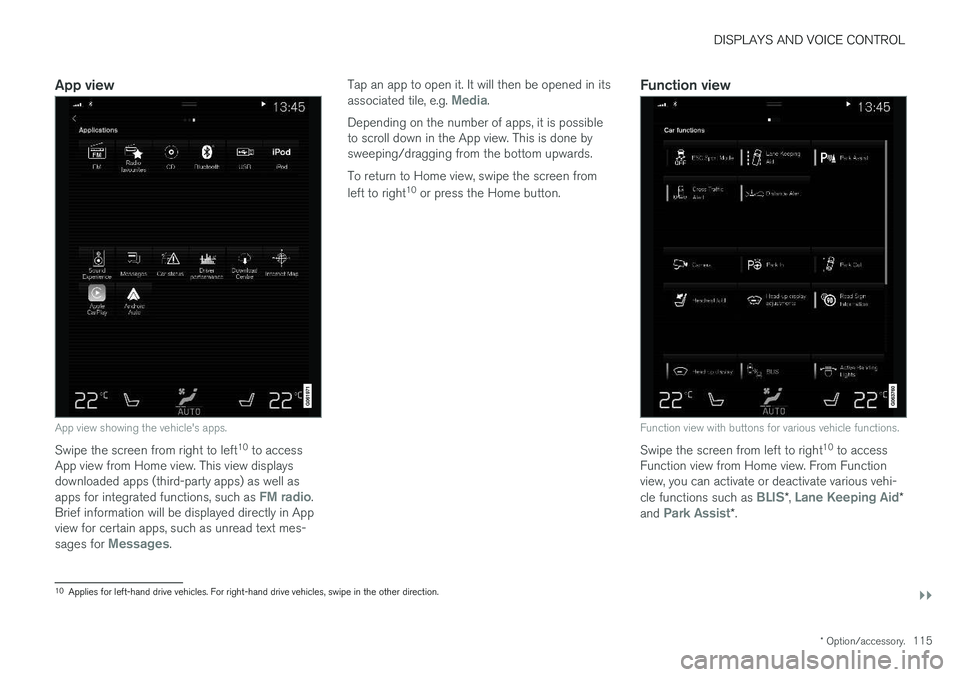
DISPLAYS AND VOICE CONTROL
}}
* Option/accessory.115
App view
App view showing the vehicle's apps.
Swipe the screen from right to left 10
to access
App view from Home view. This view displays downloaded apps (third-party apps) as well as apps for integrated functions, such as
FM radio.
Brief information will be displayed directly in App view for certain apps, such as unread text mes- sages for
Messages. Tap an app to open it. It will then be opened in its associated tile, e.g.
Media.
Depending on the number of apps, it is possible to scroll down in the App view. This is done bysweeping/dragging from the bottom upwards. To return to Home view, swipe the screen from left to right 10
or press the Home button.Function view
Function view with buttons for various vehicle functions.
Swipe the screen from left to right 10
to access
Function view from Home view. From Function view, you can activate or deactivate various vehi- cle functions such as
BLIS* , Lane Keeping Aid*
and Park Assist* .
10
Applies for left-hand drive vehicles. For right-hand drive vehicles, swipe in the other direction.
Page 266 of 660
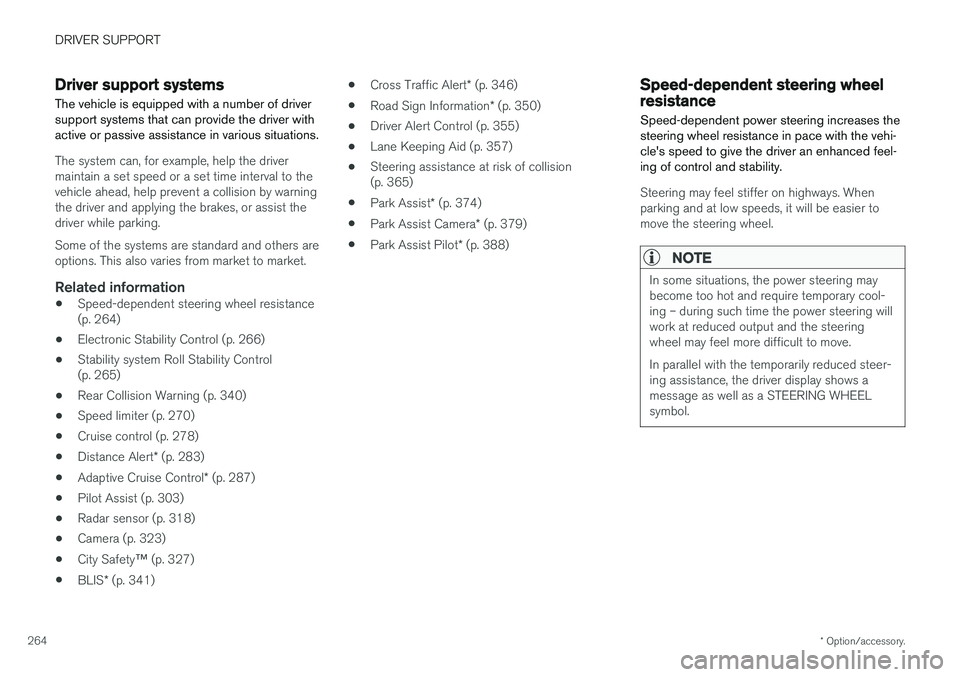
DRIVER SUPPORT
* Option/accessory.
264
Driver support systems
The vehicle is equipped with a number of driver support systems that can provide the driver withactive or passive assistance in various situations.
The system can, for example, help the driver maintain a set speed or a set time interval to thevehicle ahead, help prevent a collision by warningthe driver and applying the brakes, or assist thedriver while parking. Some of the systems are standard and others are options. This also varies from market to market.
Related information
• Speed-dependent steering wheel resistance(p. 264)
• Electronic Stability Control (p. 266)
• Stability system Roll Stability Control(p. 265)
• Rear Collision Warning (p. 340)
• Speed limiter (p. 270)
• Cruise control (p. 278)
• Distance Alert
* (p. 283)
• Adaptive Cruise Control
* (p. 287)
• Pilot Assist (p. 303)
• Radar sensor (p. 318)
• Camera (p. 323)
• City Safety
™ (p. 327)
• BLIS
* (p. 341) •
Cross Traffic Alert
* (p. 346)
• Road Sign Information
* (p. 350)
• Driver Alert Control (p. 355)
• Lane Keeping Aid (p. 357)
• Steering assistance at risk of collision(p. 365)
• Park Assist
* (p. 374)
• Park Assist Camera
* (p. 379)
• Park Assist Pilot
* (p. 388)
Speed-dependent steering wheelresistance
Speed-dependent power steering increases the steering wheel resistance in pace with the vehi-cle's speed to give the driver an enhanced feel-ing of control and stability.
Steering may feel stiffer on highways. When parking and at low speeds, it will be easier tomove the steering wheel.
NOTE
In some situations, the power steering may become too hot and require temporary cool-ing – during such time the power steering willwork at reduced output and the steeringwheel may feel more difficult to move. In parallel with the temporarily reduced steer- ing assistance, the driver display shows amessage as well as a STEERING WHEELsymbol.
Page 267 of 660

DRIVER SUPPORT
* Option/accessory.265
WARNING
While the power steering is working at reduced power, the driver support functionswith steering assistance are not available. In such a situation, the driver display shows the
Power steering failure or Power
Steering Assist Temporarily Reduced
message, combined with a STEERING WHEEL symbol.
Changing the level of steering wheel resistance *
To change the level of steering wheel resistance, see the description of the INDIVIDUAL optionunder "Available drive modes" in the "Drivemodes" section. On models not equipped with drive mode con- trols and the INDIVIDUAL option, steering wheelresistance can instead be set in the center dis-play's Top view under:
SettingsMy CarDrive ModesSteering force
Steering wheel resistance settings cannot be accessed when turning at speeds above10 km/h (6 mph).
Related information
•Drive modes
* (p. 417)
• Pilot Assist (p. 303) •
City Safety steering assistance for evasivemaneuver (p. 335)
• Lane Keeping Aid (p. 357)
• Steering assistance at risk of collision(p. 365)
• Park Assist Pilot
* (p. 388)
Stability system Roll StabilityControl
The Roll Stability Control (RSC 1
) system helps
minimize the risk of a rollover in the event of e.g. a sudden evasive maneuver or if the vehiclebegins to skid.
The RSC system monitors the lateral angle at which the vehicle is leaning and registers anychanges. Using this information, the system cal-culates the likelihood of a rollover. If there is animminent risk of a rollover, Electronic StabilityControl is activated, engine torque is reduced andbrakes are applied to one or more of the wheelsuntil the vehicle has regained stability.
WARNING
The vehicle
Page 298 of 660
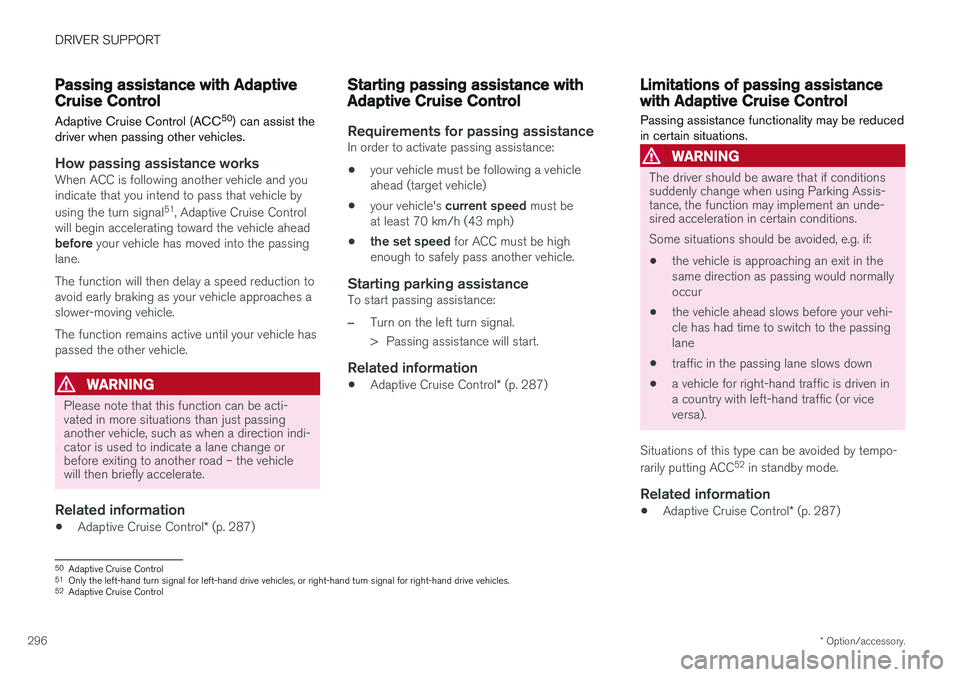
DRIVER SUPPORT
* Option/accessory.
296
Passing assistance with AdaptiveCruise Control Adaptive Cruise Control (ACC 50
) can assist the
driver when passing other vehicles.
How passing assistance worksWhen ACC is following another vehicle and you indicate that you intend to pass that vehicle by using the turn signal 51
, Adaptive Cruise Control
will begin accelerating toward the vehicle ahead before your vehicle has moved into the passing
lane. The function will then delay a speed reduction to avoid early braking as your vehicle approaches aslower-moving vehicle. The function remains active until your vehicle has passed the other vehicle.
WARNING
Please note that this function can be acti- vated in more situations than just passinganother vehicle, such as when a direction indi-cator is used to indicate a lane change orbefore exiting to another road – the vehiclewill then briefly accelerate.
Related information
• Adaptive Cruise Control
* (p. 287)
Starting passing assistance withAdaptive Cruise Control
Requirements for passing assistanceIn order to activate passing assistance:
• your vehicle must be following a vehicle ahead (target vehicle)
• your vehicle's
current speed must be
at least 70 km/h (43 mph)
• the set speed
for ACC must be high
enough to safely pass another vehicle.
Starting parking assistanceTo start passing assistance:
–Turn on the left turn signal.
> Passing assistance will start.
Related information
• Adaptive Cruise Control
* (p. 287)
Limitations of passing assistancewith Adaptive Cruise Control
Passing assistance functionality may be reduced in certain situations.
WARNING
The driver should be aware that if conditions suddenly change when using Parking Assis-tance, the function may implement an unde-sired acceleration in certain conditions. Some situations should be avoided, e.g. if: • the vehicle is approaching an exit in the same direction as passing would normallyoccur
• the vehicle ahead slows before your vehi-cle has had time to switch to the passinglane
• traffic in the passing lane slows down
• a vehicle for right-hand traffic is driven ina country with left-hand traffic (or viceversa).
Situations of this type can be avoided by tempo- rarily putting ACC 52
in standby mode.
Related information
• Adaptive Cruise Control
* (p. 287)
50
Adaptive Cruise Control
51 Only the left-hand turn signal for left-hand drive vehicles, or right-hand turn signal for right-hand drive vehicles.
52 Adaptive Cruise Control
Page 314 of 660

||
DRIVER SUPPORT
312
Automatic standby mode
Pilot Assist is dependent on other systems, such as Electronic Stability Control (ESC65
). If any of
these other systems stops working, Pilot Assist will automatically switch off.
WARNING
With automatic standby mode, the driver is warned by an acoustic signal and a messageon the instrument panel. • The driver must then regulate vehicle speed, apply the brakes if necessary, andmaintain a safe distance to other vehicles.
Adaptive Cruise Control may go into standbymode if, e.g.: • the driver opens the door.
• the brake temperature is high.
• the driver's hands are not on the steering wheel.
• the parking brake is applied.
• the engine speed (rpm) is too low/high.
• the driver unbuckles the seat belt.
• one or more of the wheels lose traction.
• the camera/radar sensor is covered by snowor heavy rain (the camera lens/radar wavesare blocked) •
your vehicle's speed goes below 5 km/h(3 mph) and Pilot Assist cannot determine ifthe vehicle ahead is stationary or if it isanother object, e.g. a speed bump.
• your vehicle's speed goes under 5 km/h(3 mph) and the vehicle ahead turns so thatPilot Assist no longer has a vehicle to follow.Reactivating Pilot Assist from standby
mode
Note: This illustration is general and details may vary depending on model.
To reactivate Pilot Assist:
–Press the button on the steering wheel
(1).
> Speed will be set to the most recently stored speed.
WARNING
A noticeable increase in speed may follow when the speed is resumed with the
steering wheel button.
Related information
• Pilot Assist (p. 303)
65
Electronic Stability Control
Page 315 of 660
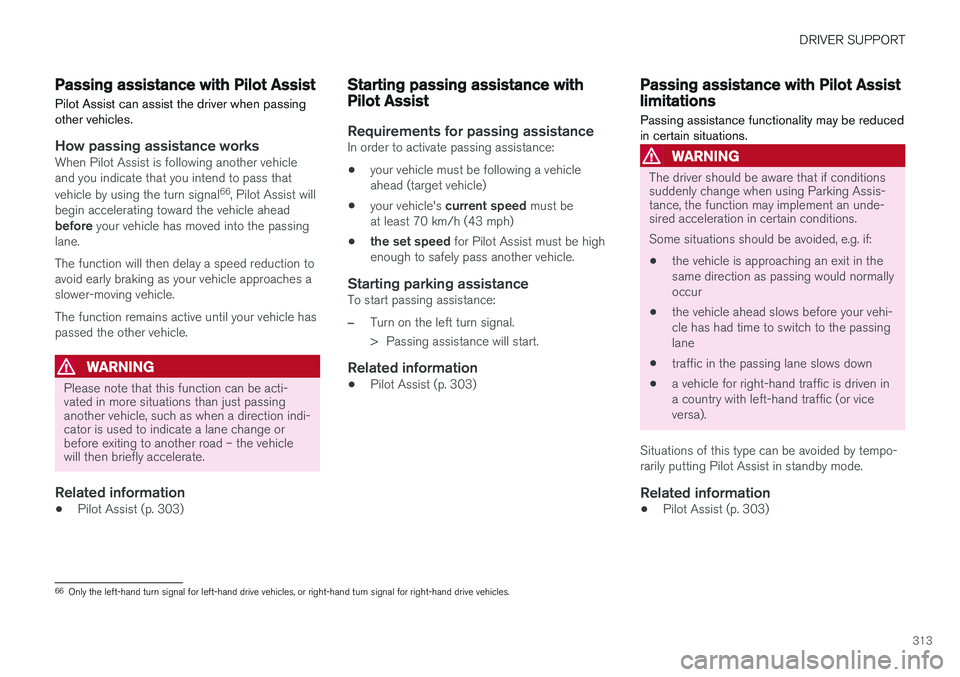
DRIVER SUPPORT
313
Passing assistance with Pilot Assist
Pilot Assist can assist the driver when passing other vehicles.
How passing assistance worksWhen Pilot Assist is following another vehicle and you indicate that you intend to pass that vehicle by using the turn signal 66
, Pilot Assist will
begin accelerating toward the vehicle ahead before your vehicle has moved into the passing
lane. The function will then delay a speed reduction to avoid early braking as your vehicle approaches aslower-moving vehicle. The function remains active until your vehicle has passed the other vehicle.
WARNING
Please note that this function can be acti- vated in more situations than just passinganother vehicle, such as when a direction indi-cator is used to indicate a lane change orbefore exiting to another road – the vehiclewill then briefly accelerate.
Related information
• Pilot Assist (p. 303)
Starting passing assistance withPilot Assist
Requirements for passing assistanceIn order to activate passing assistance:
• your vehicle must be following a vehicle ahead (target vehicle)
• your vehicle's
current speed must be
at least 70 km/h (43 mph)
• the set speed
for Pilot Assist must be high
enough to safely pass another vehicle.
Starting parking assistanceTo start passing assistance:
–Turn on the left turn signal.
> Passing assistance will start.
Related information
• Pilot Assist (p. 303)
Passing assistance with Pilot Assistlimitations
Passing assistance functionality may be reduced in certain situations.
WARNING
The driver should be aware that if conditions suddenly change when using Parking Assis-tance, the function may implement an unde-sired acceleration in certain conditions. Some situations should be avoided, e.g. if: • the vehicle is approaching an exit in the same direction as passing would normallyoccur
• the vehicle ahead slows before your vehi-cle has had time to switch to the passinglane
• traffic in the passing lane slows down
• a vehicle for right-hand traffic is driven ina country with left-hand traffic (or viceversa).
Situations of this type can be avoided by tempo-rarily putting Pilot Assist in standby mode.
Related information
• Pilot Assist (p. 303)
66
Only the left-hand turn signal for left-hand drive vehicles, or right-hand turn signal for right-hand drive vehicles.